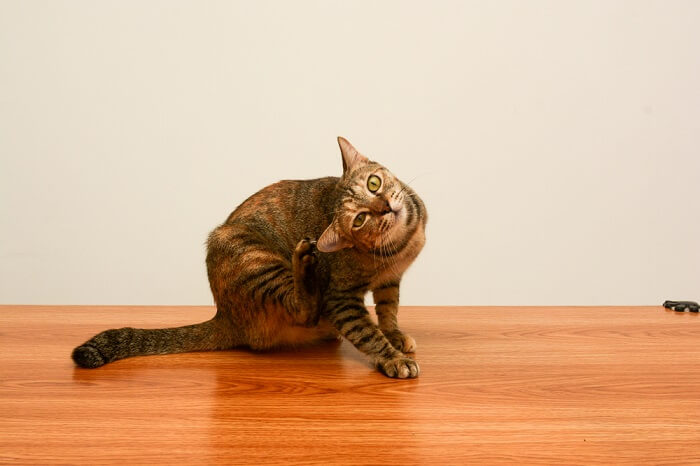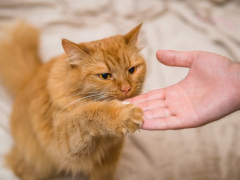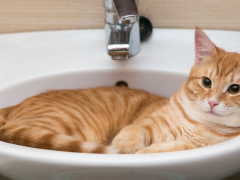
Bravecto Plus topical solution for cats is a brand of topical flea, tick, intestinal parasite, and heartworm preventative product developed by Merck Animal Health. In this article you’ll learn what Bravecto Plus for cats is, how it works, potential side effects, appropriate dosing, and some frequently asked questions.
Bravecto Plus For Cats Overview
About Bravecto Plus for Cats
Bravecto Plus is the brand name for the prescription-only combination medication containing fluralaner, a member of the isoxazoline class of antiparasitics, and moxidectin, a member of the milbemycin class of macrocyclic lactone antiparasitics.
In the US, it is labeled for killing and preventing fleas, flea infestations, intestinal roundworms and hookworms, and two species of ticks, the black-legged or deer tick, and the American dog tick. It is also a preventative for mosquito-borne heartworms.
Bravecto products have also been used in an off-label manner to treat cats with ear mites (Otodectes cynotis) and skin conditions caused by infestations from the skin mites Demodex gatoi and Demodex cati.
It has also been found to be effective against a Caribbean fur mite Lynxacarus radovsky, and the Australian paralysis tick Ixodes holocyclus.
Regular Bravecto for cats does not have activity against intestinal parasites or mosquito-borne heartworms in cats. For additional information, see the article on regular Bravecto for Cats.
Although Bravecto Plus is a topically-applied product, the drug is absorbed systemically, the same as the oral products used for dogs.
What Does Bravecto Plus Do for Cats?
The first active ingredient in Bravecto Plus for cats, fluralaner, works against fleas and ticks by blocking a primary inhibitory neurotransmitter called GABA. By inhibiting an inhibitory neurotransmitter, fluralaner causes overstimulation and uncontrolled nerve activity in the insects targeted, leading to death.
The second active ingredient, moxidectin, works by affecting chloride channels in the nervous system of arthropods (like fleas) and nematodes (like roundworms and heartworms), which leads to paralysis and death of the parasites.
According to the manufacturer, Bravecto Plus has been shown to effectively kill 100% of fleas within 12 hours of application, and nearly 100% of American dog tick and black-legged ticks by 48 hours after application. It was 100% effective in preventing heartworm infections in cats when given within 2 months of infection. It was not shown effective beyond this two-month period.
Bravecto Plus continues to work and be effective for up to 12 weeks for fleas and the black-legged tick, but it has only been found to have efficacy against the American dog tick for 8 weeks. This is similar to regular Bravecto. But because it’s efficacy as a heartworm preventative lasts for only 8 weeks, the manufacturer lists the Bravecto Plus product as needing to be given every 2 months.
Side Effects of Bravecto Plus for Cats

While Bravecto Plus is effective at preventing heartworm disease in cats, the manufacturer states that caution should be used in applying the product to a cat suspected or confirmed to be heartworm positive.
When used properly, side effects to Bravecto Plus for cats appear to be uncommon. Bravecto Plus for cats is labeled only for cats over 6 months of age. Topical products like Bravecto Plus for cats should never be ingested. Safety has not been evaluated for pregnant or lactating cats.
According to the manufacturer, side effects of Bravecto Plus for cats are very uncommon but vomiting, generalized hair loss (not at the application site), and itching were most often reported. In a controlled field study involving about 175 cats, just under 6% of treated cats showed signs of vomiting.
About 5% of cats showed signs of hair loss that was generalized and not limited to the application site. Itching both generalized and at the application site was seen in about 4% of cats. Other adverse effects including lethargy, diarrhea, and dry skin were seen in less than 4%.
While considered uncommon, the Food and Drug Administration (FDA) has advised that drugs in the isoxazoline class have the potential for causing neurologic adverse reactions including muscle tremors, difficulty with balance and walking (ataxia), and seizures.
This has been seen even in pets without a prior history of neurologic disease and should be avoided or used very cautiously cats with a history of seizures.
While Bravecto Plus is effective at preventing heartworm disease in cats, it is not intended to be a treatment to kill an active heartworm infection. The manufacturer states that caution should be used in applying the product to a cat suspected or confirmed to be heartworm positive.
In the field study, nearly all cats exhibited signs of hypersalivation (drooling) due to ingestion of the product from grooming and licking after application. The hypersalivation was found to be self-limiting and no additional adverse effects were seen.
This does raise an important point, as topical products like Bravecto Plus for cats are often very bitter tasting. If a kitty were to lick recently applied Bravecto Plus off either themselves or a housemate, the bitter taste alone can lead to excessive drooling, agitation, and sometimes even vomiting.
According to DVM360’s article “Toxicology Brief: The 10 most common toxicoses in cats” this effect is typically not true toxicity, but a sometimes dramatic reaction to the bitter taste. Providing milk or liquid from a tuna can help resolve the signs in short order.
To avoid this from happening, it is important to apply any topical flea/tick product to the skin in front of the shoulder blades at the back of the neck, a location even the most flexible cat cannot reach to lick. In multiple cat households where lots of co-grooming occurs, separating housemate kitties for up to 24 hours after application to allow the product to fully dry may be advisable.
Although Bravecto products for dogs and cats contain similar active ingredients, any oral and topical dog products should never be used for cats.
If you have any concerns for potential toxicity, even if you think your kitty might have just licked some Bravecto Plus off her fur and is having a bitter taste reaction, always be sure to contact ASPCA Animal Poison Control (1-888-426-4435) or the Pet Poison Helpline (1-855-764-7661). A fee does apply, but your vet will often need the toxicologist’s advice to help develop a treatment plan for your cat.
Bravecto Plus for cats is not known to interact with any other medications. However, you should consult with your veterinarian if you are considering combining Bravecto Plus with any other topical flea/tick, intestinal parasite, or heartworm products.
Lastly, it is best to avoid contact with any flea/tick preventative solution during application and to wash your hands after. Make sure the solution is dry on your cat before touching the application site, and make sure to keep it out of reach of children.
For Bravecto Plus, the manufacturer additionally notes that if the product accidentally gets on your skin, creating a sticky residue that does not come off with regular hand washing, applying 70% isopropyl alcohol will help to remove the residue.
Bravecto Plus for Cats Dosage

Unlike the regular Bravecto for cats, Bravecto Plus is typically applied every 8 weeks, because the indication for heartworm prevention is limited to 2 months.
There are three doses available for Bravecto Plus for cats, which are based on a cat’s weight. Always make sure to apply the proper dose for your cat’s weight.
Bravecto Plus for cats is typically applied every 8 weeks. This is largely because of the indication for heartworm prevention being limited to 2 months. This is important to note, because the regular Bravecto for cats product is indicated for an application every 3 months (except in cases where an American dog tick infestation is a significant concern, in which case the manufacturer also recommends a 2-month application cycle).
Always follow all instructions on the packaging for any topical product you use for your kitty. Bravecto Plus tubes first need to be removed from their pouch packaging. The cap should then be rotated clockwise or counterclockwise for one full turn.
The cap is intended to remain on for application and should not be removed. The contents of the tube can then be applied by parting the fur and applying to the skin along the back of the neck in front of the shoulders where a kitty cannot reach to lick it off of himself.
The manufacturer recommends not bathing a kitty for at least 3 days after application of Bravecto. Bathing shortly before application may also reduce its effectiveness.
If for some reason you are unsure if the product was administered correctly or whether all of it was applied, it is usually safest to not apply an additional dose.
If you have any questions about the application or safety of Bravecto Plus for cats or any topical product, make sure to get in touch with your veterinarian.
Conclusion
Bravecto Plus for Cats is considered an effective and safe option for most cats for killing fleas and ticks, killing and preventing intestinal parasites, and preventing heartworm infections. While it has a more limited range of effects compared to some other topical products, the need to only apply it every 2 months may be more appealing for some kitty parents.
Frequently Asked Questions
What is the Difference Between Bravecto and Bravecto Plus for Cats?
The main difference between the two products is the addition of moxidectin in Bravecto Plus. On top of flurilaner’s effects against fleas and ticks, moxidectin adds a spectrum of effect against intestinal roundworms and hookworms, as well as prevention against mosquito-borne heartworms.
Another main difference to note is that because Bravecto Plus has only been shown to be effective against heartworms for 2 months, it is labeled for an 8 week application cycle. This differs from regular Bravecto for cats, which is labeled for 12 week application cycles as it is effective against fleas and the black-legged (deer) tick for this length of time. In cases of treating American dog tick infestations, the manufacturer does recommend two month treatment cycles.
What Does Bravecto Plus Treat in Cats?
Bravecto Plus is effective at killing adult fleas, the black-legged tick (deer tick), the American dog tick, the roundworm Toxocara cati, and hookworm Ancylostoma tubaeforme. It is also effective in preventing infections caused by the mosquito-borne heartworm Dirofilaria immitis.
For adult fleas and the black-legged tick, it has been shown to be effective for 3 months. However, because it is only effective against the American dog tick, heartworms, roundworms, and hookworms for 2 months, it is labeled for 2 month application cycles.
How Do You Give a Cat Bravecto Plus?
Bravecto Plus is a medication for topical use applied to the skin at the back of the neck at the base of the skull in cats. For full information on dosage and application, see the Bravecto Plus for Cats Dosage section above.
How Long Does It Take Bravecto Plus to Work on Cats?
Bravecto Plus has been found to effectively kill all adult fleas on a cat within 12 hours of application. Within 48 hours, it was found to kill nearly 100% of American dog ticks and black-legged ticks.
For intestinal parasites, the manufacturer does not state specifically how long it takes to eliminate roundworms and hookworms, but it would typically be expected that a single application that lasts for two months would eliminate these two parasites from the digestive tract.
For heartworms, it is important to remember that Bravecto Plus for cats is not intended to be a treatment and would not be expected to kill adult heartworms. According to the American Heartworm Society (AHS), there is no medication labeled for treatment to eliminate heartworm disease in cats.
Because dogs are the ideal hosts for heartworms, many cats infected may eliminate heartworm on their own, though secondary disease like heartworm-associated respiratory disease (HARD), heart problems, and even neurologic disease from migrating worms can still be a major medical concern for some cats.
AHS maintains that the only means of fully protecting cats from the effects of heartworm disease is through prevention, which Bravecto Plus is effective for.








My cat aged 8 was given Bravecto Plus for the first time by the Vet on the 19th August 2022. The second does was applied by the vet in November this year and it would appear that my cat has an adverse reaction to the product. He is a black and white cat and up until the first application of Bravecto Plus his fur was thick, in good condition and the white was white. However, the white fur on his legs and feet has taken on a dark grey colour and he is suffering from hair loss. I have been in contact with the vet and am taking my cat to see the vet tomorrow. Prior to using this product he had always Stronghold applied by me and there were no issues. I am extremely concerned about his condition and wonder whether any other people have experienced the same problems after their cat was given Bravecto Plus??
Hi Sue,
I have not specifically encountered what you’re seeing. Seeing application site concerns like hair loss, crusting, scabbing, etc., have been reported with any topical medication to some degree, and have been seen with Bravecto Plus as well. I was not clear if the hair loss you described was localized or generalized. Seeing more generalized hair and coat changes like you describe with the pigmentation change would indeed be odd as related to a spot-on product. If your vet determines that another cause besides Bravecto Plus seems unlikely, it would be a good idea to touch base with the manufacturer (Merck Animal Health) to report the findings.
5 HOURS AFTER APPLYING BRAVECTO PLUS TO MY 12 1/2 YR OLD BLACK & WHITE CAT, HE STARTED BREATHING HEAVY, HIS PUPILS FULLY DILATED, PANTING, PACING AND THE WON’T STOP BATHING HIMSELF. I DON’T KNOW IF I NEED TO TACKING INTO THE EMERGENCY VET OR THIS IS SOME SIDE AFFECT THAT ISN’T LISTED. HE SEEMS TO CALM DOWN SOME WHEN I WIPE HIM DOWN WITH A WARM WASHCLOTH AND BRUSH HIM. HE HAS GONE 12 YEARS WITH NO FLEA MEDICATION UNTIL NOW.
Tracy, I would recommend taking your cat to the vet if they are a experiencing negative reaction.